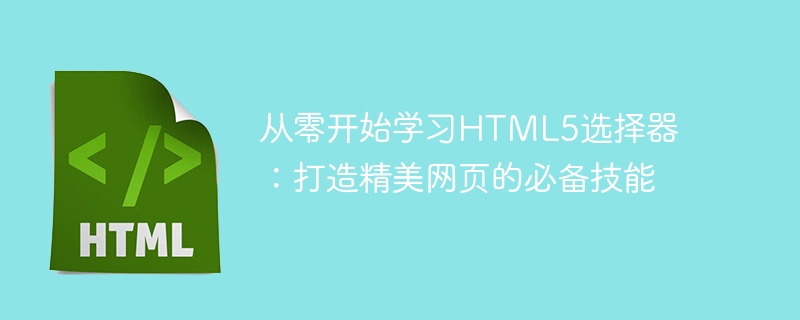

Learn HTML5 selectors from scratch: essential skills for creating beautiful web pages
HTML5 selectors are a very important part of web development. They help us position and Manipulate elements on the web page. In this article, we will learn HTML5 selectors from scratch and provide specific code examples to help readers better understand and use these selectors.
First, let’s review the basics of HTML5. HTML is a markup language used to describe the structure and content of web pages. In HTML, all elements are encapsulated in tags, and selectors use these HTML tags to select and operate elements on the web page.
HTML5 selectors can be divided into two categories: basic selectors and combined selectors.
Basic selectors are the simplest and most basic way to select HTML elements. Below we introduce several commonly used basic selectors:
Element selector:
Element selector selects elements through HTML tag names. For example, to select all paragraph elements (
), you can use p as the selector:
p {
color: red;
}Class selector:
The class selector selects items with the same class Name element. Style control is done by adding class attributes to HTML tags and using class selectors in CSS style sheets. For example, the class selector highlight selects all elements with the highlight class:
.highlight {
background-color: yellow;
}ID selector: The
ID selector selects elements with a unique ID. Style control is done by adding the id attribute on the HTML tag and using the ID selector in the CSS stylesheet. For example, select elements with header ID through the ID selector header:
#header {
font-size: 24px;
}A combined selector is a combination of multiple basic selectors used to select elements more accurately. Below we introduce several commonly used combination selectors:
Descendant selectors:
Descendant selectors select elements through inclusion relationships. Just use spaces to separate different selectors. For example, to select all strong elements under paragraph elements (
), you would use the following style rule:
p strong {
font-weight: bold;
}Direct child element selector:
Direct child element Selectors select elements through parent-child relationships. Use the greater than sign (>) to separate different selectors. For example, to select all paragraphs (
) that are direct child elements under a div element, you would use the following style rule:
div > p {
margin: 10px;
}Attribute Selector:
Attribute Selector Select elements by their properties. There are a variety of attribute selectors to choose from, for example, to select all image elements with the src attribute:
img[src] {
border: 1px solid black;
}The above are just a small part of the HTML5 selectors, there are many more types The selector can be used for more precise element selection. By mastering these selectors, we can better control and customize the style of web pages.
To summarize, HTML5 selectors are essential skills in web development. Mastering them can help us create beautiful web pages. In this article, we introduced basic and combined selectors and provided concrete code examples. I hope that readers can master the usage of HTML5 selectors through learning and practice, and further improve their web development skills.
The above is the detailed content of Learn to use HTML5 selectors: key skills for creating beautiful web pages. For more information, please follow other related articles on the PHP Chinese website!